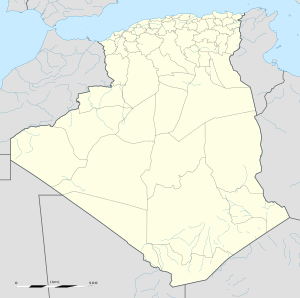History
Ancient history
In Ptolemy's Geography, IV, iii, 7, the city is mentioned under the name of Mileum or Mireon. During the Roman era it was called Colonia Sarnensis Milevitana, after the River Sarnus in Campania, whence the colonists had emigrated. This name is often found in the inscriptions of the city. Together with Cirta, Collo and Rusicade, Milevum formed the confederation known as the Four Colonies, the territory of which was very extensive. In the 6th century the Byzantine Emperor Justinian had Milevum enclosed by a fortified wall, which still stands and forms a rampart for the Muslim city of Mila. [1] It has yielded quite a number of Latin inscriptions from this city and a colossal statue of Saturn.
Under Arab Islamic rule
Between 665 and 682 the city was conquered by the Umayyad Arabs commanded by Abu al-Muhajir Dinar.
In multiple book mentioned precisely City Mila conquered by Abu Muhajer General Umayyad Dinar in 675 AD in it, says in "The Berbers: study on the conquest of Africa by the Arabs, according to the printed Arabic texts. "Volume 1 by Henri Fournel on page [2] The Mosque Sidi Ghanem of Mila was built around 675 by Abu Muhajer Dnar Dinar [3] In the tenth century AD, historian and geographer Abu Ubayd-Allah Abd Al-Bakri quoted the mosque of Sidi Ghanem as "the first Mila mosque adjoining Dar El Imara" (House of Command)
As multiple significant evidence was found of Mila in the Arab period, as standard weight of 745 Umayyad registered with: "'Translation: "In the name of Allah. Among the steps ordered / Emir Abd al-Rahman ibn Habib / Masal ibn Hammad, Wali Mila / twenty ûkîya (once) in the year 127-745)/" The name of the governor mentioned on the standard is well known: ‘Abd al-Rahmān ibn Habīb, the grandson of ‘Uqba ibn al-Nāfī’, who governed the Maghreb between 744 and 754 after returning from Spain, where he had taken refuge following the disastrous battle of Tangiers. [4]
In the 11th-century al-Bakri describes the Mila population as consisting of Arabs, people from the militia, and people of mixed race (Arabic, Roman and Berber). [5]
But according to al-Idrissi it remained in the 11th century that there were 4000 Kutama Berbers throughout Ifriqiya [6]
Ottoman rule
Finally in the 19th century it was the largest colony Koulouglis of the East-Algeria (Constatinnois) (mix of Turk with Arab or Berber) [7]
French colonial era
According to the scientist and military E.Carette (1808–1890), author of the tribal map of Algeria, and studies "inquiry into the origin and migration of the main tribes of North Africa, particularly of Algeria '"on page 453 there was a Mila 19th century about 800 ethnic Arabs and 800 ethnic Berbers in the city [8] Milevum, modern Arabic name Mila, was under French colonial rule a city in the department of Constantine in Algeria, with in the early 20th century 8000 inhabitants, 400 of whom are Europeans.
Modern history
Constantine department later became Constantine Province after the independence of Algeria, of which Mila was dependent till the creation of Mila Province in 1984. At the 1998 census the city had a population of 59,959.
Ecclesiastical history
Milevum was among the many towns of sufficient importance in the Roman province of Numidia, in the papal sway, to become a suffragan diocese.
The historically recorded bishops of this episcopal see were
- Pollianus, present at the Council of Carthage called by Cyprianus of Carthage on the lapsi , Christians who accepted forced pagan sacrificing to avoid martyrdom, himself martyred two years later
- Optatus, noted for his work De schismate Donatistarum (circa 375) against the Donatist heresy; he died in about 385 and is commemorated on 4 June
- Honorius, deposed for incompetence according to Church Father Augustine of Hippo
- Severus, fellow-countryman and correspondent of the above Augustine; attended, with his schismatical Donatist counterpart Adeodato, the Council of Carthage of 411, with other African bishops of both sides
- Morcelli next list Optatus II, who was probably in fact bishop of Vescera
- Bennatus participated in the Council of Carthage of 484, called by king Huneric of the Vandal Kingdom, after which he was exiled, like most Catholic bishops
- Restitutus, who attended the Fifth Œcumenical Council in Constantinople in 553.
Two church councils were held at Milevum, one in 402 and the other in 416. The second appealed to Pope Innocent I for repression of the Pelagian heresy.
The bishopric is last mentioned, as one of the thirteen subsisting suffragan sees in Numidia, in the Notitiae Episcopatuum in the reign of Byzantine emperor Leo VI (886-912).
Titular see
The diocese was nominally restored, no later than the 17th century, as Latin titular bishopric of Milevum (Latin) / Milevi (Curiate Italian) / Milevitan(us) (Latin adjective).
It has had the following incumbents, mostly of the fitting Episcopal (lowest) rank, with two archiepiscopal exceptions:
- Joseph Ignace Randrianasolo (1997.10.24 – 1999.06.03)
- José Manuel Piña Torres (1958.05.12 – 1997.07.07)
- Jean-Félix de Hemptinne (1932.03.22 – 1958.02.06)
- Anton Gisler (1928.04.20 – 1932.01.04)
- Titular Archbishop: Acacio Chacón Guerra (1926.05.10 – 1927.08.01)
- Giovanni Borzatti de Löwenstern (1907.03.11 – 1926.02.17)
- James Bellord (1899.02.05 – 1905.06.11)
- Charles Lavigne (1887.09.13 – 1898.08.27)
- Jean-Marie Tissot (1863.08.11 – 1886.09.01)
- William Bernard Allen Collier (1840.02.14 – 1847.12.07)
- Thomas Coen (1816.01.26 – 1831.10.09)
- Wilhelm Joseph Leopold Willibald von Baden (1779.07.12 – 1798.07.09)
- Anton Révay (1754.05.20 – 1776.09.16)
- Caius Asterius Toppi (1728.11.15 – 1754)
- Johann Ignaz Dlouhovesky (1679.04.10 – 1701.01.10)
- Hyacinthus de Saldanha (1675.01.28 – ?)
- Emmanuel a S. Ludovico (1672.02.08 – ?)
- Titular Archbishop Joseph Chennoth (車納德) (born India) (1999.08.24 – ...) as papal diplomat : Chargé d’affaires in PR China (1995.04.26 – 1999.08.24), Apostolic Nuncio (ambassador) to Chad (1999.08.24 – 2005.06.15), Apostolic Nuncio to Central African Republic (1999.08.24 – 2005.06.15), Apostolic Nuncio to Tanzania (2005.06.15 – 2011.08.15), Apostolic Nuncio to Japan (2011.08.15 – ...)

Lambaesis (Lambæsis), Lambaisis or Lambaesa, is a Roman archaeological site in Algeria, 11 km (7 mi) southeast of Batna and 27 km (17 mi) west of Timgad, located next to the modern village of Tazoult. The former bishopric is also a Latin Catholic titular bishopric.
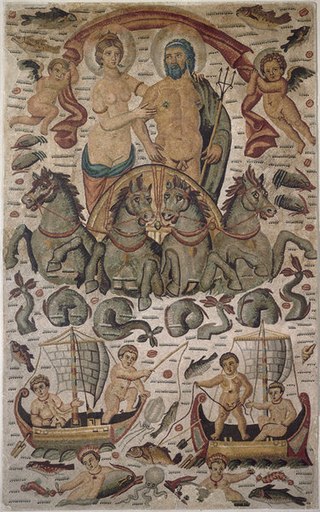
Cirta, also known by various other names in antiquity, was the ancient Berber, Punic and Roman settlement which later became Constantine, Algeria.
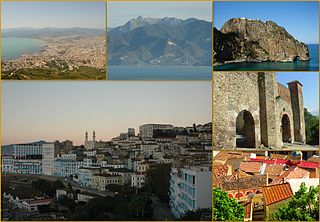
Béjaïa formerly Bougie and Bugia, is a Mediterranean port city and commune on the Gulf of Béjaïa in Algeria; it is the capital of Béjaïa Province.
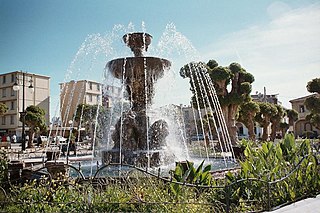
Cherchell is a town on Algeria's Mediterranean coast, 89 kilometers (55 mi) west of Algiers. It is the seat of Cherchell District in Tipaza Province. Under the names Iol and Caesarea, it was formerly a Roman colony and the capital of the kingdoms of Numidia and Mauretania.

Saldae was an important port city in the ancient Roman Empire, located at today's Béjaïa. It was generally a crossroads between eastern and western segments of Northern Africa, from the time of Carthage to the end of the Byzantine Empire from the continent.

The Muslim conquest of the Maghreb or Arab conquest of North Africa by the Rashidun and Umayyad Caliphates commenced in 647 and concluded in 709, when the Byzantine Empire lost its last remaining strongholds to Caliph Al-Walid I. The North African campaigns were part of the century of rapid early Muslim conquests.

Kusaila ibn Malzam was a 7th-century Berber Christian ruler of the kingdom of Altava and leader of the Awraba tribe, a Christianised sedentary Berber tribe of the Aures and possibly Christian king of the Sanhaja. Under his rule his domain stretched from Volubilis in the west to the Aurès in the east and later Kairouan and the interior of Ifriqiya. Kusaila is mostly known for prosecuting an effective Berber military resistance against the Muslim conquest of the Maghreb in the 680s. He died in one of those battles in 688.

Milevum was a Roman–Berber city in the Roman province of Numidia. It was located in present-day Mila in eastern Algeria.
The Banu Ifran or Ifranids, were a Zenata Berber tribe prominent in the history of pre-Islamic and early Islamic North Africa. In the 8th century, they established a kingdom in the central Maghreb, with Tlemcen as its capital.
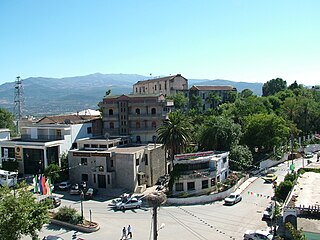
El Milia ( الميلية) is a town and commune in Jijel Province, Algeria.
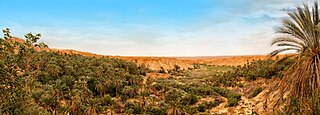
Negrine is a town and commune in Tébessa Province in north-eastern Algeria. It was the site of ancient Casae Nigrae, a settlement of Roman North Africa with an attached bishopric that remains a Latin Catholic titular see.

Caesarea in Mauretania was a Roman colony in Roman-Berber North Africa. It was the capital of Mauretania Caesariensis and is now called Cherchell, in modern Algeria.

Madauros was a Roman-Berber city and a former diocese of the Catholic Church in the old state of Numidia, in present-day Algeria.

Tiddis was a Roman city that depended on Cirta and a bishopric as "Tiddi", which remains a Latin Catholic titular see.
Azura was an ancient civitas and bishopric in Roman North Africa. It remains only as Latin Catholic titular see.

Bagai was a Roman–Berber city in the province of Africa Proconsularis. It must have been of some reasonable size, as it was also the seat of an ancient Catholic bishopric. The ancient city has been identified with ruins at Ksar-Bagaï outside of Baghai, in the Aurès Mountains of the El Hamma District in Khenchela Province, Algeria.
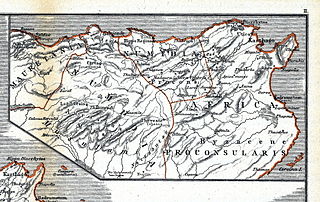
Numidia was a Roman province on the North African coast, comprising roughly the territory of north-east Algeria.

The Kingdom of the Aurès was an independent Christian Berber kingdom primarily located in the Aurès Mountains of present-day north-eastern Algeria. Established in the 480s by King Masties following a series of Berber revolts against the Vandalic Kingdom, which had conquered the Roman province of Africa in 435 AD, Aurès would last as an independent realm until the Muslim conquest of the Maghreb in 703 AD when its last monarch, Queen Dihya, was slain in battle.
Iaudas or Iabdas was a Berber leader of the sixth century and king of the Kingdom of the Aurès who held the Byzantines in check for a long time in the Aurès, and played an important role in the Berber revolts following the Byzantine reconquest.
The Aurès Mountains are located in northeastern Algeria. The mountains are part of the Saharan Atlas in Maghreb. The indigenous ethnic inhabitants of the Aurès, are the Chaoui people, part of the wider Berber (Amazigh) community. The history of the Aurès begins in prehistory.
This page is based on this
Wikipedia article Text is available under the
CC BY-SA 4.0 license; additional terms may apply.
Images, videos and audio are available under their respective licenses.


